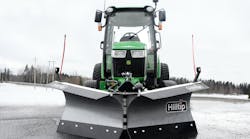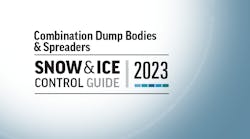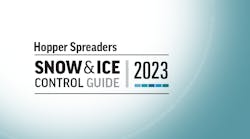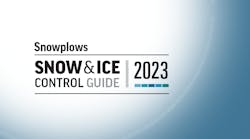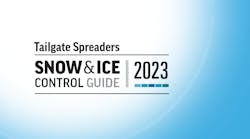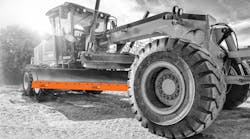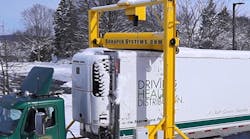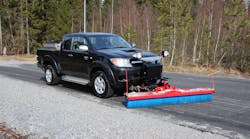THE most significant changes in the manufacturers' guidelines for snowplow mounting for the 2011 model year come from General Motors.
GM's Ken Joye said there are “major changes” in the CK lineup for heavy duty, with a brand new chassis and increased gross vehicle weights (GVW).
The front clips were revamped, so there is new sheet metal on the hood, fenders, bumpers, and grills for both Chevrolet and GMC. There are all-new full perimeter boxed frames in the 20000 and 30000, all-new suspensions front and rear, and higher front and rear payloads and GVWs. On 20000 series pickups, the GVW goes up to 10,000; on 30000 series pickups, to 13,000; and on 31000 series chassis cabs, to 13,200.
“Now you can put a snowplow on any of our pickups in the 20000 series on up and not have to worry about not having enough front-axle payload,” he said. “There are no mechanical changes. It's all torsion bar adjustments that you can make to get your ride height where you want it on all 20000, 30000, and 31000 series trucks. If they order VYU, they shouldn't have any issues at all.Table 1: GMT900 K-Series Snow Prep Package (click thumbnail to view)
“We still don't recommend putting snowplows on ST Colorado Canyons because there's not enough front available payload.”
Ford's Ken Tyburski, Ford's supervisor of product information for special vehicle engineering, said there have been slight changes in some of the frames on the front end that require different brackets.
“We've been working with snowplow manufacturers because they're not compatible '10 to '11,” he said. “Through NTEA meetings, all major manufacturers have that information. We've provided the frame-end information and all clearance data where the lines are routing versus 2010 to all snowplow builders. There were a few changes, but they weren't drastic.”
Also, starting with the 2011 MY, Ford will no longer offer a snowplow prep package option on any F-150 models and will not be recommending the 2011 F-150 for use in any snowplow application.
Chris Borczon, chassis engineer for Dodge Trucks' commercial vehicle team, said that because last year featured the new truck launch, there's nothing new for this year.
General Motors
Table 2: GMT900 Trailer Ratings (lb) (click thumbnail to view)
Prior to installing a front-mounted snowplow, the following process should be followed and necessary information obtained:
-
Establish vehicle curb weight.
-
Establish chassis manufacturer's front and rear axle weight ratings.
-
Chevrolet and GMC truck dealers can provide availability, specifications, GVWR, and Front and Rear GAWR. For vehicles already built, this information can be found on the certification label installed on the driver's door/frame or provided on the cover of the Incomplete Vehicle Document.
The following information should be obtained and provided by the manufacturers of snowplows and salt spreaders:
-
Specifications, weights, and center of gravity data.
-
Vehicle installation guidelines and instructions.
-
Calculation of weight distribution for the front and rear axles.
The loaded vehicle with driver, passenger, aftermarket accessories, snowplows, spreader, and cargo must not exceed the GVWR, and Front and Rear GAWR.
In addition, the completed curb weight vehicle, with all installed aftermarket accessories, snowplow, and spreader, and with 400 lb distributed in the driver-passenger area of the vehicle, must have a center of gravity that is located within the trapezoid formed by the coordinates A, B, C, D, H1 and H2, plus it must be to the rear of vertical line E and forward of vertical line F as defined in the Allowable Center of Gravity charts. If the center of gravity does not fall within the specified trapezoid, ballast weight may be required to shift the center of gravity until it falls within the specified trapezoid.
The snowplow manufacturer and the installer of the aftermarket equipment should determine the amount of rear ballast required to ensure that the vehicle, with the attached snowplow and aftermarket equipment, complies with the Allowable Center of Gravity Trapezoid and the resulting front and rear weight distribution ratio as defined in the Allowable Center of Gravity Charts published in the GM manual.
The use of rear ballast weight may be required to prevent exceeding the GAWR of the front axle. The use of rear ballast weight may be required to ensure that the center of gravity location of the completed vehicle, with the attached snowplow and other installed equipment, complies with the Allowable Center of Gravity Trapezoid and the resulting front and rear weight distribution ratio, even though the actual front weight may be less than the GAWR of the front axle. In either case, the rear ballast weight should be securely attached in the cargo box or behind the rear axle of the vehicle in a manner that prevents it from moving during driving and stopping.
To help avoid personal injury, refer to Z-height setting procedure before adjusting torsion bars. If torsion bars are adjusted for aftermarket equipment, be sure to return them to specification when the equipment is removed. Otherwise, a front shock absorber may dislodge and damage a front brake line. This could result in an accident when minimum stopping distances are required.
Ford Trucks
Minimum recommended equipment for the F-150: regular cab 4×4, 144.5" wheelbase, 8' pickup box; or SuperCab 4×4, 163" wheelbase, 8' pickup box.
Snowplow prep package (option code 63A) includes FGAWR upgrade to 4300 lb (4300 lb spring rating).
Heavy Duty Payload package (option code 627) includes: 8200-lb GVWR; 4050-lb FGAWR (4050-lb spring rating); 4800-lb RGAWR (4900-lb spring rating); rear axle capacity upgrade to 5300 lb and 10.5" diameter ring gear 4.10 ratio, limited-slip not included but available; 17"×7.5" J 7-lug steel wheels; LT245/70R×17D BSW all-season tires (5); 5.4L, 3-valve V8 engine, 4R75E automatic transmission; Super Engine Cooling (1.42" core thickness); auxiliary transmission air cooler, oil-to-water increased to 9-channel/18-plate; battery upgrade to 72 amp-hr/650 CCA; fuel tank (35.7-gallon capacity).
Snowplow weights (maximum recommended):
-
Regular Cab 750 lb (700 lb removable plow assembly plus 50 lb permanently attached hardware).
-
SuperCab 610 lb (560 lb removable plow assembly plus 50 lb permanently attached hardware).
Table 3: Ford Super Duty F-series Pickup Weight Limits (click thumbnail to view)
The vehicle must not be operated when overloaded. A vehicle is overloaded when the weight of the completed vehicle with aftermarket equipment installed, plus driver, passengers, and cargo, exceeds either the FGAWR, RGAWR, or GVWR established by Ford Motor Co and displayed on the Safety Compliance Certification Label.Table 4: Ford Super Duty F-series Chassis Cab Weight Limits (click thumbnail to view)
The addition of ballast weight placed rearward of the rear axle may be required to prevent exceeding FGAWR, and provide good vehicle braking and handling. The ballast should be attached securely to the vehicle with consideration for the normal driving dynamics of snowplowing and occupant safety in accidents.
For Ford completed vehicles of 10,000 GVWR or less, the weight of permanently attached aftermarket equipment must not exceed the Total Accessory Reserve Capacity displayed on the Safety Compliance Certification Label to maintain the compliance representation that came with the Ford-built vehicle. Exceeding TARC will require recertification. This applies only to the permanently attached equipment, such as the snowplow frame mounting hardware, and not to the removable portion of the snowplow blade assembly.
Front end wheel alignment (toe) and headlight aim may require readjustment after installation of snowplow equipment. Failure to reset front wheel alignment may cause premature uneven tire wear. If required, reset to chassis manufacturer's specifications found in the Ford Shop Manual.
Installation of any inductive load devices such as electric motors, or electric clutches for clutch pumps, must not be connected to Ford vehicle wiring or fuse panels. Power for such devices should be taken directly from the battery or starter motor relay power terminal. Control of these devices should be achieved via relays. No direct current path should exist between Ford vehicle wiring and the installed load that is not filtered by the battery. These recommendations are intended to eliminate or minimize any induced reverse voltage into the Ford circuitry.
Dodge Trucks
The loaded vehicle, including all aftermarket accessories, the snowplow system, passengers, and cargo, must not exceed the gross vehicle weight (GVW), front or rear gross axle weight (GAW) ratings specified on the Safety Compliance Certification label located in the driver's side door opening.
The empty truck with all permanently attached accessories and snowplow components must not exceed 62% of its total weight on the front axle to comply with FMVSS/CMVSR 105 Brake Certification. Permanently attached snowplow parts are those parts not easily removed when the blade is removed. The permanently attached parts are: subframe, hydraulic pump, hydraulic lift cylinder, lamps, wiring, snowplow controls, etc. If the front axle loading exceeds either 62% of the empty truck total weight, or the front GAWR, ballast compensating weight must be securely attached at the rear of the truck to bring front axle weight within weight specifications.
Notes for heavy-duty snowplows:
-
At any time, the maximum number of occupants in the truck must not exceed two.
-
Under any circumstances, vehicles should not exceed GVWR (Gross Vehicle Weight Rating), front or rear GAWRs (Gross Axle Weight Ratings).
-
Snowplow prep packages are not available with Sport (AAG) package.
-
Cargo capacity will be reduced by the addition of options.
-
Ballast should be securely attached inside the box at 9" from the rear tailgate for pickups.
-
The total weight of permanently attached hardware should not exceed 125 lb.
-
Max snowplow weight should not exceed values for models shown in this section.
This article is part of our annual Snow & Ice Control issue. Find additional coverage on this topic, including a directory of product offerings from leading snow and ice control equipment manufacturers, in the Snow & Ice Control Guide.
